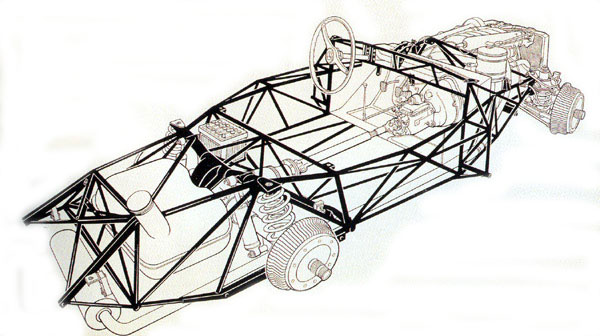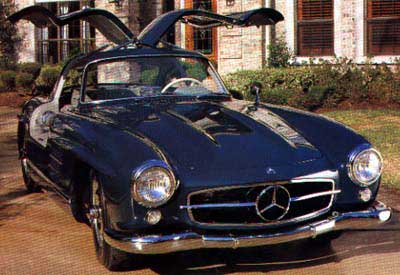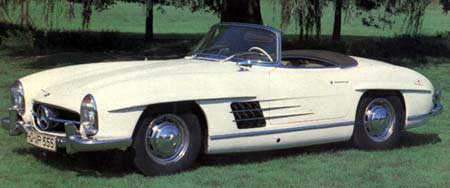
![]()
HISTORY
of the 300SL-----------------------

On the race track, the 300SL is a symbol of invincibility. This was it's intended function after all, to revive Daimler Benz competition in racing. On the road, the 300SL is one of the most desirable automobiles ever built. Because it was built for racing, the bodyshell was designed for aerodynamic efficiency. As a result, it had flattened flanks, little imagination was applied to the front end, and there was a lack of trim.
 Mercedes
Benz did not originally want to build the road going version of their
famous racecar. A New Yorker named Max Hoffman put in an order for 1000
vehicles and the road going version of the 300SL was born. These first
cars had a US sticker price of $6820.00 rising to a final $8902.00 by
the end of the production run.
Mercedes
Benz did not originally want to build the road going version of their
famous racecar. A New Yorker named Max Hoffman put in an order for 1000
vehicles and the road going version of the 300SL was born. These first
cars had a US sticker price of $6820.00 rising to a final $8902.00 by
the end of the production run.
The road going version of the racecar was restyled. Proven on the racetrack, the 300SL engine was extremely reliable. The engine, slanted to the left (see photo) was neccessary to accomodate the low hood line. Oher changes and refinements included a steel bodyshell with aluminum hood, trunklid, lower rocker panels and doors to save weight. Chromed bumpers were added. The slatted vents on the front fenders were there to allow excess heat from the engine, but also added to the overall styling of the car. As do the "eyebrow" moldings over the wheel well arches. The standard interior consisted of checked cloth fabric similar to that which was used on the racing version. Leather of course was an option, as were fitted leather suitcases. All of the gullwing coupes were built as left hand drive cars.
During the run of the gullwing coupe, 29 all aluminum bodied 300SL's were built for special delivery to racing customers. They had the plaid seats, plexiglass windows, Rudge wheels and an "NSL" engine.
 The
photo at left shows Rudolph Ulenhaut's spaceframe chassis of the 300SL
coupe.
The
photo at left shows Rudolph Ulenhaut's spaceframe chassis of the 300SL
coupe.
The redesigned SL roadster was not only functional, but breathtakingly beautiful. Production of the 300SL coupe began to wane as news of the roadster began to spread. The roadster was a road-going version that was a revised car that fully addressed all the bugs of the coupe. The roadster was heavier and slower, but the styling was much more civilized.The car had overall the same appearance except for being a convertible and the doors were front hinged. The front fenders on the roadster have larger cut-outs to accomodate revised headlights with integral foglights, therefore front fenders on the coupe and roadster cannot be interchanged.
There are quite alot of features on the roadster version, which were missing from the gullwing. The fuel tank filler flap was moved to the outside of the left rear fender. Standard features were a Talbot racing mirror, perforated and fluted leather upholstery, padded binnacle and top dash panel, improved heater controls, more luggage space was achieved by cutting fuel tank capacity back to 31.7 gallons, a larger tail light cluster with integral reverse lights, combination guage between the tachometer and speedometer, handbrake lever moved from the left to the right of the driver, longer windshield wipers on reinforced arms, foglamps, reinforced bumpers, glovebox, swing axle rear suspension, softtop or as an extra cost option a hardtop.
If you are interested in buying one of these great cars, it is a must that you get a professional to inspect it for you, after all, you are getting ready to spend six figures on an automobile. It is equally important to buy the best car you can afford in today’s market. It is less expensive to buy a 300 SL Roadster or Gullwing in great shape than it is to buy a ragged one and restore it. Restoration on these cars runs well into the six figures. If you buy a nice one you can enjoy it next week!
![]()
Production Numbers:
Production Numbers of the 300SL gullwing coupe from August 1954 to May 1957
| 1954 | 146 units |
| 1955 | 867 units |
| 1956 | 311 units |
| 1957
|
76
units
|
| total: | 1400 units |
![]()
Production Numbers of the 300SL Roadster from February/May 1957 to February 1963
| 1957 | 554 units |
| 1958 | 324 units |
| 1959 | 211 units |
| 1960 | 249 units |
| 1961 | 250 units |
| 1962 | 244 units |
| 1963
|
26
units
|
| total: | 1858 units |
![]()
Buying A 300SL
Know what you're buying and what to look for and know what to avoid.
When these cars are well maintained and properly taken care of, they increase in value. Currently: (these are approximate values based on actual sales of vehicles.) -------------------------------------------------------------------------------- values last updated SEPTEMBER 2016
PLEASE READ THIS FIRST!
A car's value is determined by condition. Standard condition guidelines are as follows:
Excellent- A close to perfect original or a very well restored vehicle. Generally a body-off restoration, but a well done body-on restoration that has been fully detailed may qualify. The vehicle is stunning to look at and any flaws are trivial and not readily apparent. Everything works as new, all equipment is original, NOS or excellent quality reproductions. PLEASE KEEP IN MIND THAT # 1 CARS ARE VERY RARE, AND ARE ORIGINAL RIGHT DOWN TO THE HOSE CLAMPS. DO NOT ASSUME THAT JUST BECAUSE A CAR HAS A #1 ASKING PRICE, THAT IT IS IN # 1 CONDITION. MOST CARS FOR SALE OUT THERE ARE LOW # 2 TO HIGH # 3 CARS.
Very Good- An extremely presentable vehicle showing minimal wear, or a well restored vehicle. Runs and drives smooth and tight. Needs no mechanical or cosmetic work. All areas have been detailed. Beautiful to look at but clearly not a # 1 vehicle.
Good- Presentable inside and out with some signs of wear. Not detailed but clean. Body should be straight and solid with no rust-through anywhere. Shiny, attractive paint but may have evidence of minor fading or checking or other imperfections. Runs and drives well but may need some minor mechanical or cosmetic work. But it is useable and enjoyable as is.
Fair- Runs and drives ok but needs work throughout the vehicle. Body shows signs of wear or previous restoration work. Any rust should be minimal and not in any structural areas. Cosmetics, body and mechanicals all need work to some degree.
Poor- In need of complete restoration, but is complete and not a rust bucket beyond repair. May or may not run but is not roadworthy.
These values are from Collector Car Market Review and are based on actual sales of vehicles, not on asking prices of vehicles. Asking prices, and sales prices are very different.
| Gullwing Coupe (1954-1957) | |
| # 1 EXCELLENT | $1,890,000.00 |
| # 2 VERY GOOD | $1,335,000.00 |
| # 3 GOOD | $1,030,000.00 |
| # 4 FAIR | $684,000.00 |
| # 5 POOR | $511.000.00 |
| Roadster (1957-1960) | |
| # 1 EXCELLENT | $1,450,000.00 |
| # 2 VERY GOOD | $1,000,000.00 |
| # 3 GOOD | $766,500.00 |
| # 4 FAIR | $527,750.00 |
| # 5 POOR | $287,500.00 |
| Roadster (1961-1963) | |
| # 1 EXCELLENT | $1,535,000.00 |
| # 2 VERY GOOD | $1,060,000.00 |
| # 3 GOOD | $810,000.00 |
| # 4 FAIR | $560,000.00 |
| 5 POOR | $305,000.00 |
Keep in mind that due to the high cost of restoration, mint examples of these cars can and have sold for more than the prices quoted here.
Condition of a car CANNOT be determined by its location. Don't be fooled by a car's current geographical location. Just because a car is in California today, does not mean that is where it started life.
Where to find the engine number and chassis number.
The chassis plate is attached to the engine firewall, another plate and stamping is found on the left side front chassis leg close to the tubular transverse member. (see photo right).
The engine number can be found stamped into the right hand side of the cylinder block, and repeated on the alloy plate attached below (see photo below).
Chassis number prefixs are:
- 300SL (racing version) -------------- 194010
- 300SL (production Coupe) --------- 198040
- 300SL (aluminum Coupe) ---------- 198043
- 300SL (roadster) ---------------------- 198042
Engine number prefix is M198 (for all)
The 300 SL Gullwing and Roadster are a very low production automobile. Rarity is one of the main ingredients which makes a car collectible. These fine automobiles have been collectible for a long time. Since most auto enthusiasts take better care of their investments, most of the gullwings and roadsters are in pretty good shape.
There are some gullwing and roadsters around which were haphazardly refurbished by some unscrupulous individuals in the late 1980's to cash in on that crazy market.
We strongly suggest you get a qualified third party to inspect the 300SL of your dreams. Below is a diagram for places to check for rust and previous rust repairs.

Please keep in mind that these cars were driven hard when they were young. Let's face it, you buy a sports car to drive it, therefore some of these cars have been
crashed, repaired, crashed again, and repaired again. So check the car for accident damage as well. Check the hood fit, headlight fit, door fit, trunklid fit. Check the car on a lift and inspect the tubular chassis for repairs. Park the car on a level spot, step away from the automobile and just look at the car from all angles.
Check the inner wheel aprons front and rear. Check for corrosion around the headlight buckets, wheel arches, trunk floor, the areas behind the rear wheels and the rear roof pillars. (see photo below)

Technical Specifications of the 300 SL
|
Gullwing
Coupe
|
Roadster
|
|
| Engine Type: | 6 cyl overhead camshaft (M198) | 6 cyl overhead camshaft (M198) |
| Bore and stroke: | 85 x 88 mm | 85 x 88 mm |
| Displacement: | 2996 cc | 2996 cc |
| Power output: | 215 hp@5800 rpm | 215 hp@5800 rpm |
| Compression ratio: | 8.55:1 | 9.5:1 |
| Torque: | 28 mkg @ 4600rpm | 228 ft/lb |
| Fuel Injection: | Bosch injection pump | Bosch injection pump |
| Engine speed at 100km/hr: | 3000 rpm | 3000 rpm |
| Gear ratios: | I. 3.34:1 | I. 3.34:1 |
| II. 1.97:1 | II. 1.97:1 | |
| III. 1.385:1 | III. 1.385:1 | |
| IV. 1.00:1 | IV. 1.00:1 | |
| Rear axle ratio: | 3.64 | 3.64 |
| Chassis: | tubular space frame w/ light alloy body | tubular space frame w/ light alloy body |
| Suspension: | independent front, swing axle rear with coil springs | independent front, swing axle rear with coil springs |
| Brakes and area: | drum, 1470 square cm | drum, 1470 square cm |
| Wheelbase: | 2400 mm | 2400 mm |
| Track front/rear: | 1385/1435 mm | 1398/1448mm |
| Length: | 4520 mm | 4570 mm |
| Width: | 1790 mm | 1790 mm |
| Height: | 1300 mm | 1300 mm |
| Ground clearance: | 130 mm | 130mm |
| Tires: | 6.5 x 15 super sport | 6.5 x 15 super sport |
| Turning circle: | 11.4 meters | 11.4 meters |
| Steering type and ratio: | recirculating ball, 17.3:1 | recirculating ball, 17.3:1 |
| Weight: | 1295 kg (2849 lbs) | 1330 kg (2926 lbs.) |
| Maximum speed: | 145 mph | 145 mph |
| Acceleration: | 8.7 sec 0-100 km-hr | 8.7 sec 0-100 km-hr |
| Fuel consumption | 17 L, super (13.7 mpg) | 17 L, super (13.7 mpg) |
| Fuel tank capacity | 130 L (34 gal.) | 130 L (34 gal.) |

Examples of the 300SL Gullwing and Roadster


